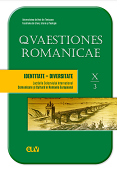Identità dei popoli di Transilvania, Moldavia e Valacchia in alcune corografie del XVI secolo
Identity of the Peoples of Transylvania, Moldavia and Wallachia in some 16th Century Chorographies
Author(s): Gizella Nemeth, Adriano PapoSubject(s): Social history, Culture and social structure , 16th Century, Identity of Collectives, Sociology of Literature
Published by: Universitatea de Vest din Timişoara
Keywords: Chorography; Gianandrea Gromo; Moldavia; Antonio Possevino; Georg Reichersdorff; Transylvania; Antonio Veranzio; Wallachia;
Summary/Abstract: In this essay we deal with the identity of the Transylvanian, Moldovan and Wallachian peoples in the light of the knowledge gained from reading some chorographic works of the sixteenth century. In particular, we have taken into account the work compiled by the Dalmatian Antonio Veranzio De situ Transsylvaniae, Moldaviae et Transalpinae, the Chorographia Transylvaniae (1550) by Georg Reichersdorff, the Transilvania by Antonio Possevino (1584), as well as both descriptions of Transylvania written by Giovanandrea Gromo in epistolary form in the years 1566–67. We also reported the considerations on this theme of the historian and poet Ascanio Centorio degli Ortensii, of the Paduan Francesco della Valle, of the Tuscan Enea Silvio Piccolomini and that of the musician Pietro Busto da Brescia as well. Antonio Veranzio, in particular, but in general all the writers mentioned above have emphasized the close coexistence and mixture of the numerous peoples who in ancient times inhabited the Balkan, Carpathian and the Danubian space. The Transylvanians, Moldovans and Wallachians, who descended from these peoples, had the main peculiarity of living in multiethnic, multicultural and multireligious regions.
Journal: Quaestiones Romanicae
- Issue Year: X/2023
- Issue No: 3
- Page Range: 57-70
- Page Count: 14
- Language: Italian

